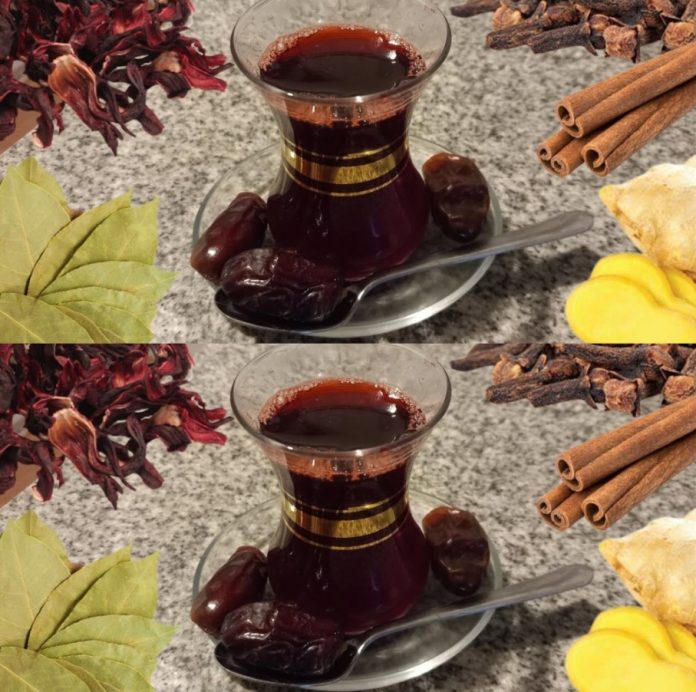In a world where wellness is increasingly at the forefront of our minds, the quest for natural remedies and health-enhancing beverages has never been more popular.
One such elixir, brimming with vibrant flavors and impressive health benefits, is Hibiscus, Ginger, Clove, and Bay Leaf Tea. This delightful infusion not only tantalizes the taste buds but also serves as a natural cleanser for your blood and organs. With its rich history in herbal medicine, this tea is celebrated for its antioxidant properties, anti-inflammatory effects, and ability to support overall wellness.
In this article, we will explore the unique benefits of each ingredient, guide you through the preparation process, and offer tips on how to incorporate this invigorating drink into your daily routine.
The Benefits of the Ingredients
Hibiscus:
Hibiscus tea, known for its deep red color and tangy flavor, is rich in vitamin C and antioxidants. It has been linked to lower blood pressure, improved heart health, and a boost to the immune system. The natural acids in hibiscus can aid in detoxification, making it a wonderful choice for a cleansing tea.
Ginger:
This spicy root has long been revered for its medicinal properties. Ginger is known to enhance digestion, reduce inflammation, and boost the immune system. Its warming qualities not only provide comfort but also promote circulation, further supporting the body’s detoxification processes.
Clove:
Cloves are aromatic flower buds that pack a powerful punch when it comes to health benefits. They are rich in eugenol, which has anti-inflammatory and antioxidant properties. Cloves also support liver function and help regulate blood sugar levels, making them an excellent addition to this cleansing tea.
Bay Leaf:
Often used in cooking, bay leaves are also prized for their health benefits. They are believed to support digestion, reduce inflammation, and have antibacterial properties. Additionally, bay leaves can help in the detoxification process, making them a perfect complement to this tea blend.
How to Prepare Hibiscus, Ginger, Clove & Bay Leaf Tea
Ingredients:
- 2 tablespoons dried hibiscus flowers
- 1-inch piece of fresh ginger (sliced or grated)
- 4-6 whole cloves
- 2-3 bay leaves
- 4 cups water
- Honey or agave syrup (optional, for sweetness)
- Lemon slices (optional, for garnish)
Instructions:
- Prepare the Ingredients:
Start by gathering your ingredients. If you’re using fresh ginger, peel and slice it into thin rounds or grate it for a more intense flavor. Measure out the dried hibiscus flowers, cloves, and bay leaves. - Boil the Water:
In a medium-sized pot, bring 4 cups of water to a rolling boil. The quality of the water can significantly affect the taste of your tea, so consider using filtered water if possible. - Add the Ingredients:
Once the water is boiling, add the hibiscus flowers, ginger, cloves, and bay leaves to the pot. Stir gently to combine. - Simmer:
Reduce the heat to low and let the mixture simmer for about 10-15 minutes. This allows the flavors and beneficial compounds to infuse into the water, creating a rich and aromatic tea. - Strain the Tea:
After simmering, remove the pot from the heat and strain the tea into a heatproof pitcher or teapot. Discard the solids. - Sweeten and Serve:
If desired, add honey or agave syrup to taste. Serve hot, or allow it to cool and enjoy it iced. Garnish with lemon slices for an added zing and a boost of vitamin C.
Tips for Enjoying Your Tea
- Experiment with Ratios: Feel free to adjust the amounts of each ingredient to suit your taste preferences. If you prefer a spicier tea, add more ginger or cloves; for a more floral taste, increase the hibiscus.
- Storage: Store any leftover tea in the refrigerator for up to three days. You can reheat it or enjoy it cold, making it a versatile drink.
- Incorporate into Your Routine: For maximum benefits, consider drinking this tea regularly, perhaps in the morning as a refreshing start to your day or in the evening as a calming ritual.
Conclusion :
Incorporating Hibiscus, Ginger, Clove, and Bay Leaf Tea into your daily routine is not just about enjoying a flavorful beverage; it’s about embracing a holistic approach to wellness. Each ingredient in this invigorating tea contributes unique properties that support various aspects of your health. Hibiscus delivers a refreshing tang while providing powerful antioxidants that combat free radicals in the body. Ginger adds a warm spice, enhancing digestion and boosting your immune system. Cloves bring their aromatic essence and anti-inflammatory benefits, supporting liver health and helping to regulate blood sugar levels. Bay leaves, often overlooked, offer digestive support and contribute to the tea’s cleansing properties.
By regularly enjoying this tea, you create a moment of mindfulness in your day—whether it’s a quiet morning ritual or a comforting evening brew. This simple act of self-care can enhance your overall well-being, helping you feel more balanced and connected to your body.
Furthermore, this tea serves as a wonderful conversation starter, allowing you to share the benefits of natural remedies with friends and family. Consider hosting a tea party where everyone can experience the vibrant flavors and health benefits of this delightful infusion.
As you embark on this journey of health and wellness, remember that the path to well-being is a personal one. Listen to your body, experiment with flavors, and adapt the recipe to suit your tastes. With each cup, you’re not only nourishing yourself but also exploring the rich tapestry of herbal traditions that have stood the test of time.
So, the next time you seek a refreshing drink that offers more than just hydration, reach for this Hibiscus, Ginger, Clove, and Bay Leaf Tea. Celebrate the harmony of flavors and health benefits in every sip, and let this rejuvenating tea cleanse and revitalize your body from the inside out. Here’s to your health and the delightful journey of discovering nature’s bountiful remedies!
Source of the picture : Barbara O’Neill










